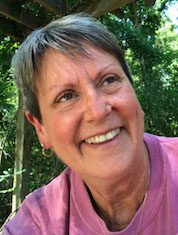 I hate needles. Not knitting or embroidery needles. The kind you stick into skin and veins, shoulders and buttocks. I must be afraid of them or of pain. Anticipation of blood tests, flu shots, or Novocain, coupled with the rub of a cotton ball and fumes of alcohol, causes the blood to drain from my head and I pass out. The medical term for my fainting is vasovagal syncope.
I hate needles. Not knitting or embroidery needles. The kind you stick into skin and veins, shoulders and buttocks. I must be afraid of them or of pain. Anticipation of blood tests, flu shots, or Novocain, coupled with the rub of a cotton ball and fumes of alcohol, causes the blood to drain from my head and I pass out. The medical term for my fainting is vasovagal syncope.
When I was fifteen, my dad took my brother, sister, and me to the high school cafeteria where the school district was giving free German measles shots with an injection gun, quick and easy. When my turn came, I hit the floor so hard my head bounced like the low dribble of a basketball.
As of late, I have to administer Veterinary Lactated Ringer’s Injection fluid – electrolytes – to Toby. Toby is my beagle. I think he’s about fourteen years old but I’m not sure. Someone hit Toby and left him for dead on Highway 21 headed south toward Hunting Island. He was destined for the ditch on the side of the road but I wasn’t having it. Surgery on his right hip broken in two places and months of slow rehab were successful. Toby and I have been together for ten years.
About seven months ago, Toby’s blood work wasn’t great, so my nephew Doug, who is also my vet, said the dog would need fluids every other day, about 250 milliliters. Dr. Doug came to our house, sat on the floor with Toby and me, and showed me how to pull up the loose skin from the back of Toby’s neck and slide in the 20G needle. It’s Toby’s puppy flap, the crepe of skin a mom dog uses to carry her pups around.
“Keep Toby still,” Doug said, “and squeeze the plastic bag to accelerate the drip until about 250 mils of saline solution make a bump about the size of a baseball.”
“Kind of like a miniature hunchback of Notre Dame,” I say.
“Something like that,” he says.
“Hmm…,” I say.
Seemed simple enough watching and listening to Doug and he offered to come by and help me again if I needed him. Doug knows I have an aversion to needles. I know it will be hard to do any single thing that hurts my buddy. The bag of fluids, line, and needles cost $38 for four treatments, the price tag for quality of a life.
“How long do I need to do this?” I ask.
“Forever,” he says.
“Yuck,” I say.
This isn’t the first time I’ve had to overcome my fears to care for another living creature. Years ago, my mother was diagnosed with Type 1 diabetes. For her, Type 1 translated into daily sticks to measure glucose levels and twice-a-day insulin injections before breakfast and dinner. We had to go to diabetes class, learn about nutrition, understand the lows and highs of sugar in the bloodstream, and the best and fastest way to elevate glucose levels or remedy excursions with a counter injection. Orange juice, donuts and Milky Way bars worked best for Irene when her sugar dropped.
When we first learned my mother was diabetic, when her glucose levels were 500 and she almost died, when she discharged from Beaufort Memorial to my house, when she moved from Pennsylvania to South Carolina, when I began as her caregiver for the next twelve years, we sat at the kitchen table and practiced putting the test strips into the monitor, lancing her fingers, watching the drop of blood crawl from her fingertip through the straw of the strip, wait for a number to appear on the small screen, and record it in her log. Then, we read the instructions for the insulin pen, learned how to rotate needles onto the pen, dial in the right dosage, test the pen by squeezing out one or two drops, tug on the roll of her belly and stick the needle in, inject the insulin, discard the needle, and store the medicine in the refrigerator. She became proficient and self-sufficient with the daily regimen but at the beginning, I tested her blood and gave her the injections. Often, I had to do these things sitting down.
We can amaze ourselves when we overcome our fears. We can avoid fainting with fresh air and deep breaths. We can push ourselves past boundaries our psyche sets. We can find the strength we need when the life of someone or something we love needs us. It’s there, underneath our skin, coursing inside the veins and arteries pumped by a heart that breaks and heals, over, and over, and over again.
I hate needles but I am grateful for what they deliver. I don’t pass out as often as I used to but I have to look away and talk about the weather when a nurse or phlebotomist draws my blood. I rub Toby’s ear with my thumb and index finger as I squeeze the bag of fluids between my arm and chest hydrating him in our in-home dialysis clinic. I remember holding onto the kitchen counter after the first few times I had to “teach” my mom how to prick her finger and inject insulin into her belly to take a breath, keep my balance, and stay standing.
When I pull up the skin on Toby’s neck, it’s like being mom to a very old dog. And somewhere, just past the edge of vasovagal syncope, I can feel my mother’s tug. We did it together. We stayed conscious through our fear. It is what love does. Keeps us conscious. The rub of an ear. A pliable belly. Soft fur. Warm skin. A deep breath, an exhale, a sigh. Conscious, through fear, through loss, through the sweet tug of skin.







